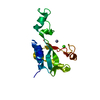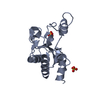+ Open data
Open data
- Basic information
Basic information
| Entry | Database: PDB / ID: 8p3a | ||||||
|---|---|---|---|---|---|---|---|
| Title | bacteriophage T5 l-alanoyl-d-glutamate peptidase Zn2+/Ca2+ form | ||||||
 Components Components | L-alanyl-D-glutamate peptidase | ||||||
 Keywords Keywords | ANTIMICROBIAL PROTEIN / l-alanoyl-d-glutamate peptidase / bacteriophage T5 / endolysin / Zn2+ and Ca2+ containing form | ||||||
| Function / homology | Hedgehog signalling/DD-peptidase zinc-binding domain superfamily / Hydrolases; Acting on peptide bonds (peptidases); Metalloendopeptidases / viral release from host cell by cytolysis / cell wall organization / peptidase activity / defense response to bacterium / metal ion binding / L-alanyl-D-glutamate peptidase Function and homology information Function and homology information | ||||||
| Biological species |  Escherichia phage T5 (virus) Escherichia phage T5 (virus) | ||||||
| Method | SOLUTION NMR / torsion angle dynamics | ||||||
 Authors Authors | Prokhorov, D.A. / Kutyshenko, V.P. / Mikoulinskaia, G.V. | ||||||
| Funding support |  Russian Federation, 1items Russian Federation, 1items
| ||||||
 Citation Citation |  Journal: Int J Mol Sci / Year: 2023 Journal: Int J Mol Sci / Year: 2023Title: Conservative Tryptophan Residue in the Vicinity of an Active Site of the M15 Family l,d-Peptidases: A Key Element in the Catalysis. Authors: Mikoulinskaia, G.V. / Prokhorov, D.A. / Chernyshov, S.V. / Sitnikova, D.S. / Arakelian, A.G. / Uversky, V.N. | ||||||
| History |
|
- Structure visualization
Structure visualization
| Structure viewer | Molecule:  Molmil Molmil Jmol/JSmol Jmol/JSmol |
|---|
- Downloads & links
Downloads & links
- Download
Download
| PDBx/mmCIF format |  8p3a.cif.gz 8p3a.cif.gz | 839.4 KB | Display |  PDBx/mmCIF format PDBx/mmCIF format |
|---|---|---|---|---|
| PDB format |  pdb8p3a.ent.gz pdb8p3a.ent.gz | 705.5 KB | Display |  PDB format PDB format |
| PDBx/mmJSON format |  8p3a.json.gz 8p3a.json.gz | Tree view |  PDBx/mmJSON format PDBx/mmJSON format | |
| Others |  Other downloads Other downloads |
-Validation report
| Summary document |  8p3a_validation.pdf.gz 8p3a_validation.pdf.gz | 405.2 KB | Display |  wwPDB validaton report wwPDB validaton report |
|---|---|---|---|---|
| Full document |  8p3a_full_validation.pdf.gz 8p3a_full_validation.pdf.gz | 555.3 KB | Display | |
| Data in XML |  8p3a_validation.xml.gz 8p3a_validation.xml.gz | 66.8 KB | Display | |
| Data in CIF |  8p3a_validation.cif.gz 8p3a_validation.cif.gz | 80.6 KB | Display | |
| Arichive directory |  https://data.pdbj.org/pub/pdb/validation_reports/p3/8p3a https://data.pdbj.org/pub/pdb/validation_reports/p3/8p3a ftp://data.pdbj.org/pub/pdb/validation_reports/p3/8p3a ftp://data.pdbj.org/pub/pdb/validation_reports/p3/8p3a | HTTPS FTP |
-Related structure data
| Related structure data | |
|---|---|
| Similar structure data | Similarity search - Function & homology  F&H Search F&H Search |
| Other databases |
|
- Links
Links
- Assembly
Assembly
| Deposited unit | 
| |||||||||
|---|---|---|---|---|---|---|---|---|---|---|
| 1 |
| |||||||||
| NMR ensembles |
|
- Components
Components
| #1: Protein | Mass: 15286.202 Da / Num. of mol.: 1 Source method: isolated from a genetically manipulated source Details: ZN - ZN2+ ION CA - CA2+ ION / Source: (gene. exp.)  Escherichia phage T5 (virus) / Gene: lys, T5.040, T5p039, orf10c / Production host: Escherichia phage T5 (virus) / Gene: lys, T5.040, T5p039, orf10c / Production host:  References: UniProt: Q6QGP7, Hydrolases; Acting on peptide bonds (peptidases); Metalloendopeptidases |
|---|---|
| #2: Chemical | ChemComp-ZN / |
| #3: Chemical | ChemComp-CA / |
| Has ligand of interest | Y |
| Has protein modification | N |
-Experimental details
-Experiment
| Experiment | Method: SOLUTION NMR | ||||||||||||||||||||||||||||||||||||||||||||||||||||||||||||||||||||||||||||||||||||||||||
|---|---|---|---|---|---|---|---|---|---|---|---|---|---|---|---|---|---|---|---|---|---|---|---|---|---|---|---|---|---|---|---|---|---|---|---|---|---|---|---|---|---|---|---|---|---|---|---|---|---|---|---|---|---|---|---|---|---|---|---|---|---|---|---|---|---|---|---|---|---|---|---|---|---|---|---|---|---|---|---|---|---|---|---|---|---|---|---|---|---|---|---|
| NMR experiment |
|
- Sample preparation
Sample preparation
| Details | Type: solution Contents: 0.8 mM [U-100% 13C; U-100% 15N] l-alanoyl-d-glutamate peptidase, 50 mM [U-100% 2H] sodium acetate, 3 mM Zn(NO3)2, 3 mM CaCl2, 0.03 % sodium azide, 90% H2O/10% D2O Details: The sample was obtained by renaturation from a solution of 8 M urea in the presence of Zn2+ and Ca2+ salts Label: endo_T5 Zn-Ca / Solvent system: 90% H2O/10% D2O | ||||||||||||||||||||||||
|---|---|---|---|---|---|---|---|---|---|---|---|---|---|---|---|---|---|---|---|---|---|---|---|---|---|
| Sample |
| ||||||||||||||||||||||||
| Sample conditions | Details: The sample remained stable throughout the entire data collection period. The stability of the sample was monitored by periodically recording 15N-HSQC spectra and comparing them. Ionic strength: 50 mM / Ionic strength err: 5 / Label: conditions_1 / pH: 4.1 / PH err: 0.05 / Pressure: AMBIENT atm / Pressure err: 0.01 / Temperature: 298 K / Temperature err: 0.2 |
-NMR measurement
| NMR spectrometer | Type: Bruker AVANCE III / Manufacturer: Bruker / Model: AVANCE III / Field strength: 600 MHz / Details: TXI probehead |
|---|
- Processing
Processing
| NMR software |
| ||||||||||||||||||||||||
|---|---|---|---|---|---|---|---|---|---|---|---|---|---|---|---|---|---|---|---|---|---|---|---|---|---|
| Refinement | Method: torsion angle dynamics / Software ordinal: 1 | ||||||||||||||||||||||||
| NMR representative | Selection criteria: target function | ||||||||||||||||||||||||
| NMR ensemble | Conformer selection criteria: target function / Conformers calculated total number: 100 / Conformers submitted total number: 20 |
 Movie
Movie Controller
Controller





 PDBj
PDBj




 HSQC
HSQC